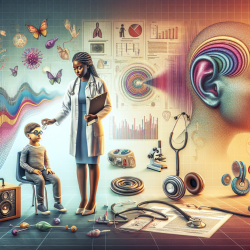Introduction
Auditory Neuropathy Spectrum Disorders (ANSD) present a unique challenge in the field of audiology and speech-language pathology, characterized by a disconnect between sound detection and speech comprehension. Despite normal otoacoustic emissions (OAEs), individuals with ANSD often exhibit abnormal auditory brainstem responses (ABRs), leading to difficulties in speech perception, especially in noisy environments. The complexity of ANSD requires a data-driven approach to diagnosis and treatment, as highlighted in the comprehensive review "Auditory Neuropathy Spectrum Disorders: From Diagnosis to Treatment: Literature Review and Case Reports" by De Siati et al. (2020).
Understanding ANSD
ANSD is characterized by a range of hearing impairments where speech perception is disproportionately affected compared to pure-tone detection thresholds. The underlying causes are varied, including genetic mutations, prenatal and postnatal factors, and structural anomalies. The study by De Siati et al. emphasizes the importance of understanding the molecular mechanisms and sites of lesion, such as the cochlear inner hair cells (IHC) and spiral ganglion neurons (SGN), to improve screening and treatment strategies.
Implications for Clinical Practice
For practitioners, the review provides several actionable insights:
- Comprehensive Audiological Assessment: Utilize a combination of OAEs, ABRs, electrocochleography (ECochG), and cortical auditory evoked potentials (CAEPs) to accurately diagnose ANSD.
- Tailored Intervention Strategies: Consider the degree of hearing loss and the specific site of lesion when recommending hearing aids or cochlear implants. Cochlear implants are particularly beneficial in cases of profound hearing loss due to IHC presynaptic disorders.
- Genetic Testing and Counseling: Incorporate genetic testing to identify specific mutations that may influence treatment outcomes and provide targeted counseling to families.
Encouraging Further Research
The review underscores the need for ongoing research into the genetic and molecular underpinnings of ANSD. Practitioners are encouraged to contribute to and stay informed about emerging studies that explore novel therapeutic approaches, such as gene therapy, which holds promise for addressing specific genetic mutations associated with ANSD.
Conclusion
ANSD presents a complex clinical challenge that requires a nuanced understanding of its varied etiologies and manifestations. By integrating the insights from De Siati et al.'s review into clinical practice, practitioners can enhance their diagnostic accuracy and treatment efficacy, ultimately improving outcomes for children with ANSD. For a deeper dive into the research, practitioners are encouraged to read the full article: Auditory Neuropathy Spectrum Disorders: From Diagnosis to Treatment: Literature Review and Case Reports.










